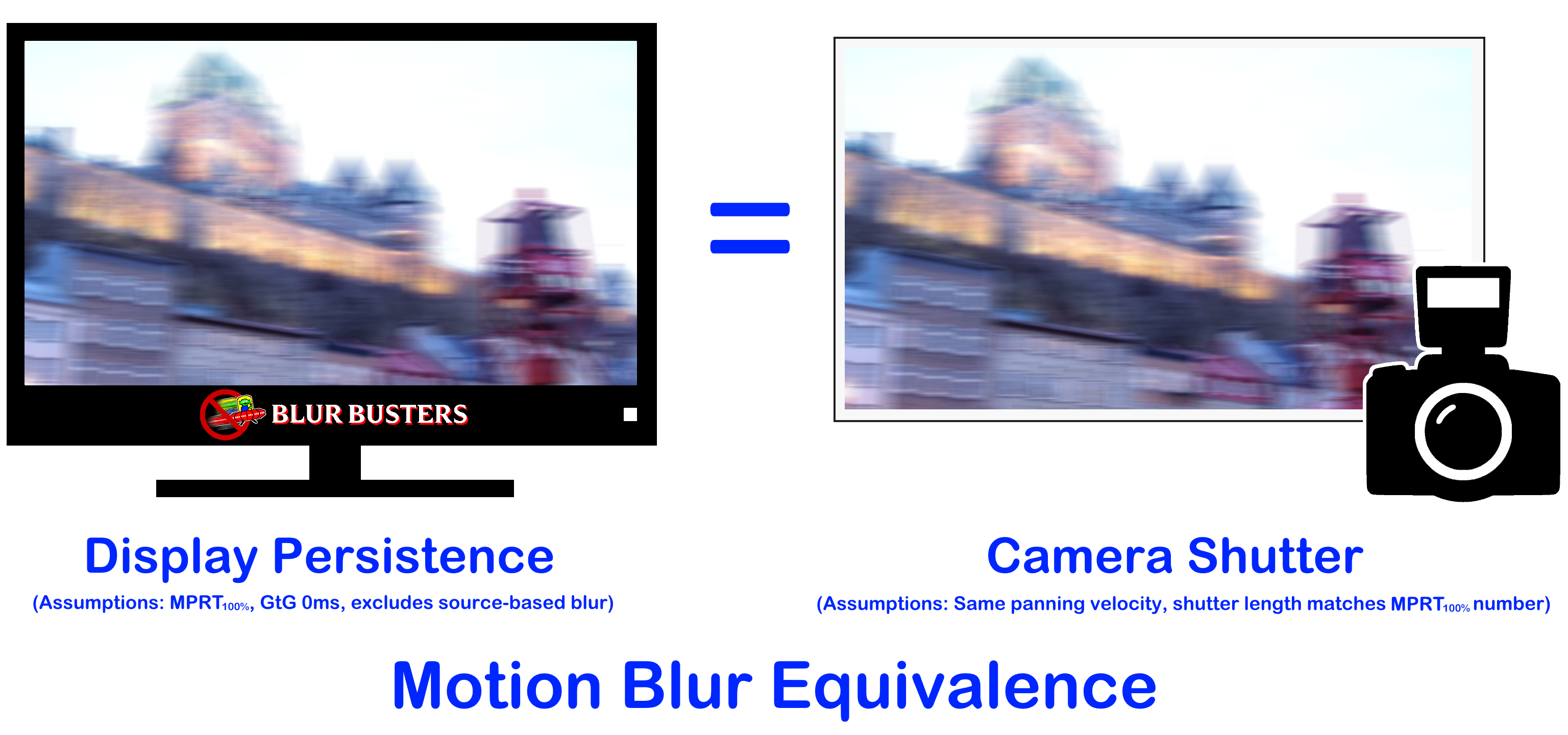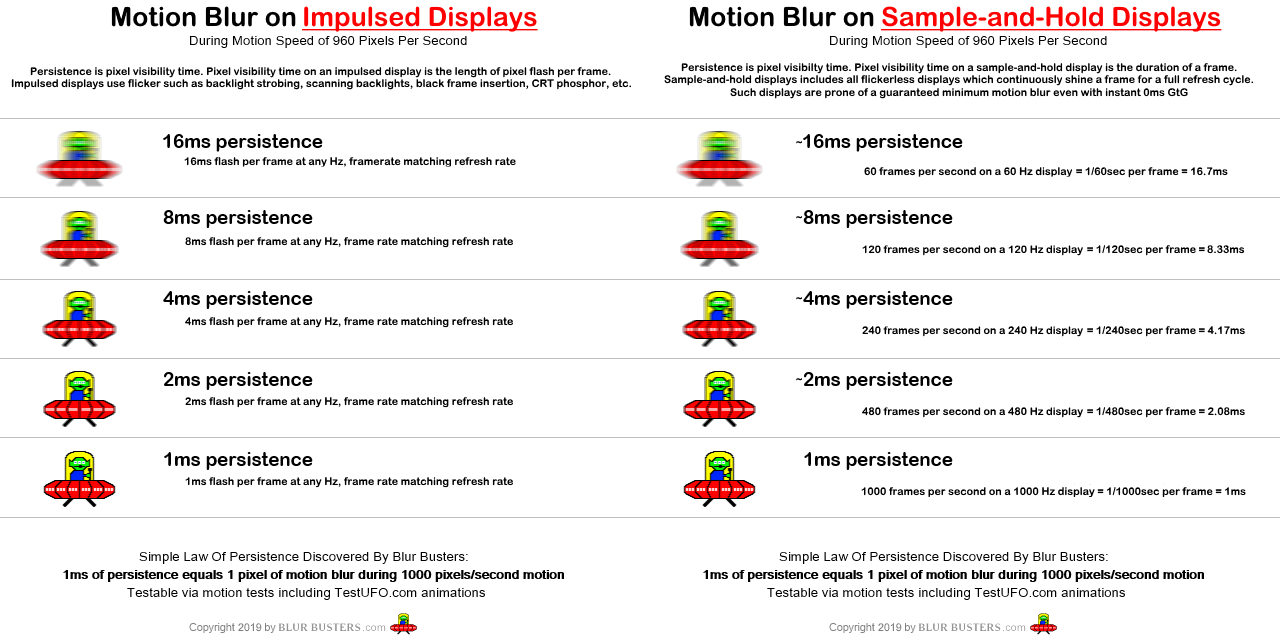Page 1 of 1
with oled, is there any reason to not use always VRR?
Posted: 11 Jun 2023, 15:14
by hart
With the almost instant response times of oled screens, does it even make sense to not use VRR always?
240hz on 90 fps, shouldn't look different than 90fs on 90hz with oled, or did I understood this wrong?
Re: with oled, is there any reason to not use always VRR?
Posted: 14 Jun 2023, 07:17
by Vorsic
OLED screens are still
sample and hold so they'll still have that blur. I don't believe there are any oled screens that let you use vrr and bfi at the same time.
Re: with oled, is there any reason to not use always VRR?
Posted: 06 Jul 2023, 11:00
by Kaled
hart wrote: ↑11 Jun 2023, 15:14
With the almost instant response times of oled screens, does it even make sense to not use VRR always?
240hz on 90 fps, shouldn't look different than 90fs on 90hz with oled, or did I understood this wrong?
Using the monitors at 240Hz while getting 90 FPS with VRR on will give better results than 90Hz with 90 FPS, because the first configuration will give better input lag results. So I think they will look identical but the input lag will be different between the two.
Jorimt and Chief Blur Buster gave me good answers here that you might find useful
Re: with oled, is there any reason to not use always VRR?
Posted: 06 Jul 2023, 21:06
by Chief Blur Buster
hart wrote: ↑11 Jun 2023, 15:14
With the almost instant response times of oled screens, does it even make sense to not use VRR always?
240hz on 90 fps, shouldn't look different than 90fs on 90hz with oled, or did I understood this wrong?
Please remember that instant response does not eliminate motion blur.
There are two pixel response standards.
Even at GtG=0, MPRT is throttled by frametime blur, as per
www.testufo.com/eyetracking (view on OLED).
You can never have less display motion blur (in milliseconds) than MAX(frametime,refreshtime) on a sample-and-hold display. So 240Hz = 1/240sec of motion blur.
For more information, see
GtG versus MPRT, The Two Pixel Response Methods.
VRR still hugely benefits OLED. But 240fps looks better on OLED than 360fps looks on LCD. There's about a 1.5x-2x blur advantage with unstrobed OLEDs versus unstrobed LCDs, due to the darn near lack of the GtG component in MPRT blur.

So you can't have less display motion blur at 240fps on any flickerless display, than a 1/240sec photograph. You need to add more framerate (and Hz) or add impulsing to reduce motion blur further.

Re: with oled, is there any reason to not use always VRR?
Posted: 06 Jul 2023, 21:10
by Chief Blur Buster
KALK4L wrote: ↑06 Jul 2023, 11:00
hart wrote: ↑11 Jun 2023, 15:14
With the almost instant response times of oled screens, does it even make sense to not use VRR always?
240hz on 90 fps, shouldn't look different than 90fs on 90hz with oled, or did I understood this wrong?
Using the monitors at 240Hz while getting 90 FPS with VRR on will give better results than 90Hz with 90 FPS, because the first configuration will give better input lag results. So I think they will look identical but the input lag will be different between the two.
Jorimt and Chief Blur Buster gave me good answers here that you might find useful
This is correct.
Always, always aim to get more Hz than you think you need, as long as you can afford it & as long as it doesn't have disadvantages.
We no longer have (mandatory) picture quality degradation for high Hz like for the first high Hz LCDs (TN). Since high Hz is now finally available in wide-gamut LCD format and OLED format. You ideally want your frame rate range completely inside your VRR range if you can -- including your 1% frame rate peaks -- so you don't have to worry about the capping stuff.
Re: with oled, is there any reason to not use always VRR?
Posted: 06 Jul 2023, 21:37
by jorimt
hart wrote: ↑11 Jun 2023, 15:14
With the almost instant response times of oled screens, does it even make sense to not use VRR always?
240hz on 90 fps, shouldn't look different than 90fs on 90hz with oled, or did I understood this wrong?
Depending on your tolerance and the given model, OLED VRR near-black flicker, for one:
viewtopic.php?f=5&t=12166&p=95019#p94998
Secondly, OLED has near 0ms GtG, which will prevent virtually all visible ghosting/smearing artifacts that are usually seen on slower LCD models, but like already mention here, OLED is sample-and-hold, so non-strobing clarity is still tied to achievable refresh + framerate ratios.
I.E. 90 FPS 240Hz OLED VRR will be lower latency than 90 FPS 90Hz non-VRR, and will have virtually no visible ghosting/smearing like equivalent LCD panels, but the given blur/double image of 90 FPS (aka "MPRT," or motion picture response time blur) will remain.

